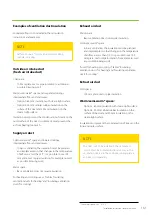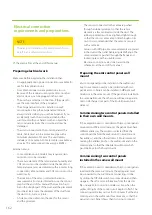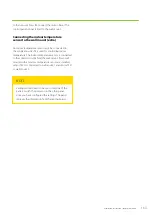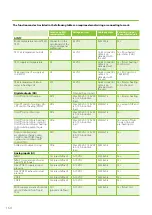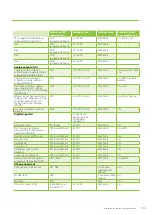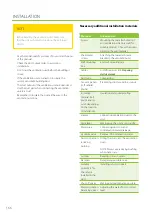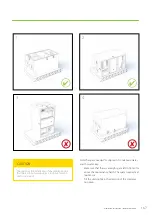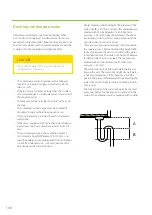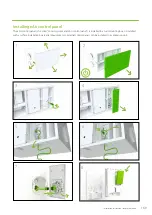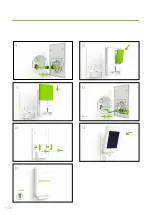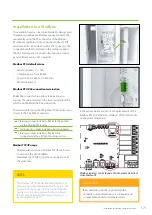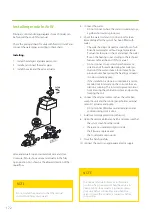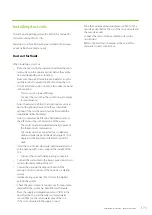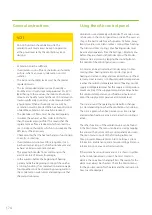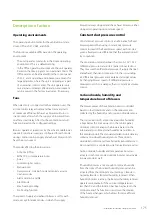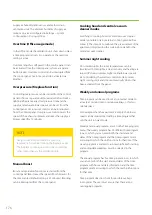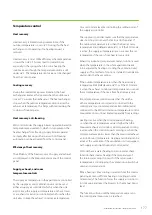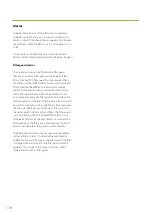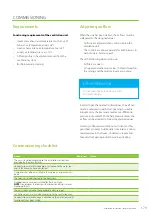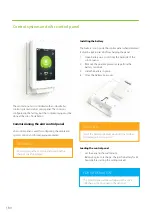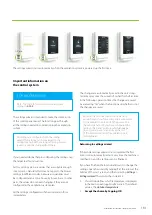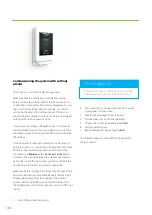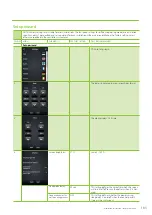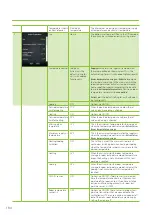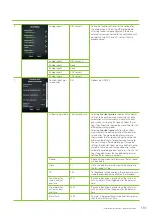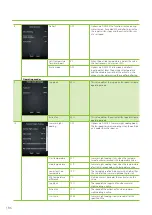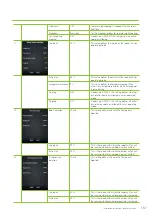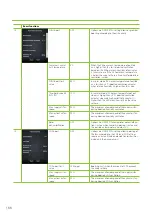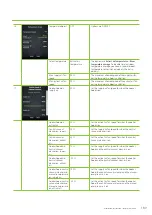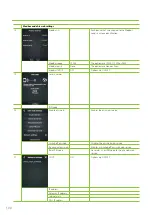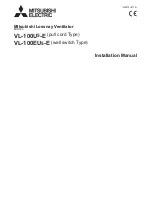
175
Installation instructions for professionals
blower is always stopped and the exhaust blower is either
stopped or operating on minimum speed.
Constant duct pressure control
Constant duct pressure control is an alternative for fixed
blower speeds. When using constant duct pressure
control, instead of the fixed blower speed, each mode is
given a fixed pressure difference that the automation will
try to maintain.
The ventilation unit motherboard has two 0–10 V / 24 V
differential pressure transmitters (extra) connected to it.
They measure the differential pressure of supply channel
and exhaust channel in comparison to the surrounding
air. Differential pressures are maintained at target values
by changing blower speeds. If differential pressure is
measured over the iris damper, that is constant air volume
control.
Carbon dioxide, humidity, and
temperature boost of blowers
The blower power of the ventilation unit is controlled
based on load conditions and on the measurements
collected by the humidity and/or carbon dioxide sensors.
The concentration of carbon dioxide and/or humidity
is kept below the limit value set in the control panel.
Humidity control manages the blowers based on the
internal and possible external humidity transmitters in
the ventilation unit. The standard ventilation unit delivery
contains one inbuilt humidity sensor. Three carbon
dioxide transmitters and three humidity transmitters can
be connected to a ventilation unit. Transmitters are extras.
Carbon dioxide, humidity and temperature boost can
activate in At home mode. Humidity booster can activate
in Away mode as well.
If humidity booster is not enough to remove humidity
from the rooms, the boosted humidity removal can be
activated from the settings menu (Settings > Booster >
Humidity Booster > Boosted humidity removal). When
humidity booster is active, the boosted humidity removal
operates automatically if the outdoor temperature is
less than 0°C and the function has been activated in the
Settings menu. This function slows down the rotation
of the heat exchangers, which allows for more efficient
humidity removal.
Description of action
Operating environments
The operating environments for the ventilation unit are
Home, Office, VAK1, VAK2, and VAK3.
The functions available differ based on the operating
environment.
•
The unit operates constantly in the Home operating
environment. This is a default setting
•
In the Office operating environment, the unit operates
based on the time program or on external control. The
Office mode can be activated from the control panel.
•
VAK1, 2, and 3 operating environments are meant for
large properties, where the unit is operating as a part
of an external control center. The unit operates only
on external commands. VAK operation environment
can be preset in the factory in advance, if necessary.
Fans
When electricity is connected to the ventilation unit, the
air lock control relay activates and heat recovery starts
at maximum efficiency. Exhaust air blower will turn on
in a moment, after which the supply air blower will turn
on after a small delay. After this the ventilation unit will
function based on the configured settings.
Blowers operate at speeds set by the active mode. Blower
speeds (or duct pressures) are configured for each mode
during commissioning. Supply and exhaust blowers both
have their own speed.
The modes affecting the blowers are:
•
At home (Office)
•
RH%, CO2, or temperature boost
•
Away
•
Summer night cooling
•
Manual boost
•
Overpressure, cooking hood and central vacuum
cleaner modes
•
Alarm modes A and AB
•
Silent mode
•
Max. heating/cooling
•
De-frosting function
The speed of supply and exhaust blower is set for each
mode, except for alarm modes, in which the supply
Summary of Contents for LTR-3 eAir
Page 8: ...8 Kanavaliitännät ulkoilma tuloilma poistoilma jäteilma ...
Page 20: ...20 11 13 9 12 Lisävaruste 1 2 min 10 ...
Page 48: ...48 ...
Page 51: ...51 Ammattilaisen asennusohje ...
Page 52: ...52 LTR 3 eAir Installationsanvisningar för ventilationsaggregat Svenska ...
Page 58: ...58 Kanalanslutningar uteluft tilluft frånluft avluft ...
Page 70: ...70 9 13 15 11 10 14 Extra tillbehör 1 2 min 12 ...
Page 98: ...98 ...
Page 101: ...101 Installationsanvisningar för yrkesfolk ...
Page 102: ...102 Installeringsinstruksjoner for ventilasjonsenheten Norsk LTR 3 eAir ...
Page 108: ...108 Kanalkoblinger utendørsluft tilluft avtrekksluft avkastluft ...
Page 120: ...120 9 13 15 11 10 14 1 2 min 12 ...
Page 148: ...148 ...
Page 151: ...151 Installasjonsinstrukser for fagfolk ...
Page 152: ...152 LTR 3 eAir Installation instructions for the ventilation unit English ...
Page 158: ...158 Duct connections outdoor air supply air extract air exhaust air ...
Page 170: ...170 9 13 15 11 10 14 Extra 1 2 min 12 ...
Page 198: ...198 ...
Page 203: ...203 Koblinger Connections ...
Page 204: ...204 ...
Page 205: ...205 ...
Page 206: ...206 ...
Page 207: ...207 ...
Page 208: ...208 ...
Page 209: ...209 ...
Page 210: ...210 ...
Page 211: ...211 ...
Page 212: ...212 ...
Page 214: ...214 eAir W Periaatekaavio eAir W Principschema eAir W Prinsippskisse eAir W Principle schema ...
Page 215: ...215 ...
Page 218: ...218 ...
Page 219: ...219 ...

